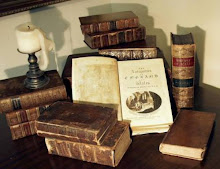For extra credit, in addition to the selected title, we also read The War of the Worlds (the translucent review concerning which has previously been posted) and The Time Machine. This second novel began its existence as early as 1888, and reportedly evolved from three distinct ideas into the final form, in 1895, we know today. The distinctive elements we recognise right away are the theory of time travel, the experiences of a Time Traveler, and a future vision.
Wells begins by laying out the theory of travel through time plainly and believably by comparison to travel through space. The experiences of the Time Traveler follow, recounted to a group of friends, though as an uninterrupted narrative for the reader. The vision comes at the end, when the Time Traveler goes back to the future, and beyond, millions of years hence. Instead of the great technology-driven worlds of microchips and interstellar life, Wells discloses a shrouded desolate landscape inhabited by monstrous crustaceans that, we are led to believe, has come about by some withering of man, first into placid leisure, and then into extinction. Having progressed to conquer all challenges and losing the ability to adapt, mankind doomed itself to atrophy.
In The Island of Dr. Moreau, first published in 1896, when Wells was thirty years old, we find the contemporaneous controversy of vivisection mixed with the future controversy of gene splicing; questions in morality of experimentation on animals; the hazards of sea travel; the evils of empire; evolution and creationism; and we also find the more broader issues of religion and existence. There also is the theme of transformation similar to another of his novels, The Invisible Man. The common thread in all Wells' writing seems to be a sort of debunked utopian outlook. Is the striving to reach beyond ourselves worth the trouble?
Poor brutes! I began to see the viler aspect of Moreau's cruelty. ... Before, they had been beasts, their instincts fitly adapted to their surroundings, and happy as living things may be. Now they stumbled in the shackles of humanity, lived in a fear that never died, fretted by a law they could not understand; their mock-human existence began in an agony, was one long internal struggle, one long dread of Moreau--and for what?Prendick, the man whose discovered narrative makes up the tale, is considering the creatures that have been born of Moreau's experimentation; yet he may also be addressing Moreau's condition: as a man, Moreau was perfectly adapted to his station in life, but in trying to understand something he could not--creation--he now faced constant fear, of his own handiwork.
The novel has much of the flavor of a writer at odds with religion. Dr. Moreau is referred to by his creatures as Him. We also watched the film version of the novel, starring Marlon Brando and Val Kilmer, in which the point is taken even further, as the creatures call Moreau Father. Prendick even thinks Moreau has hypnotised the creatures into believing he is their god. For humans today who do not understand, are they not the beasts to God's Moreau? Is God nothing but a mad scientist? The screenplay makes a few adaptations to the novel, most notably the addition of a love interest for Prendick (who is also renamed), a young woman he tries to save from reverting to beasthood, a subplot which adds nothing of substance to Wells' story. In the film, Moreau uses electical implants to control his creatures, while in the book they are heeled only by the whip and the Law--a set of rules unnatural to their beastly instincts, as precarious is the Bible and other religious tracts in restraining
men from their most natural instincts of survival: fear, flight, and fight.
At the end of the novel appears a lifeboat of the ship from which Prendick had been cast off. Inside he finds dead the captain and another man from the ship. The irony is, if Prendick had not been cast off the ship and suffered the horrors of Moreau's island, he would have died. Perhaps there is a message there, that only by facing up to the darkness of men can we hope to survive. Though Prendick has seen the worst, he also nows sees hope. Wells realised much that was horrible in human nature, yet the world's worst conflicts were still far in the future. In this and other stories, he reveals the darker shades of humanity, with hope just a glimmer of possibility. That hope is fragile, as if he wishes a better fate, but has little faith in civilization. The Island of Dr. Moreau, The War of the Worlds, and The Time Machine are works of doomsday fiction.
Though not transcendent works, these novels are interesting and thought-provoking, and in many ways remarkable when considering the time during which they were written. For a reader of broad interests ploughing through two thousand pages of A la recherche du temps perdu, some other of Wells' novels, like The Invisible Man, The First Men in the Moon, and The Food of the Gods might be quick intermissions between Swann in Love and Within a Budding Grove. We will keep those books at hand confident of a good story for when the need arises.
This along with the other Slave reviews can be found at The Slaves of Golconda. Go there to read or join in the mining.


No comments:
Post a Comment